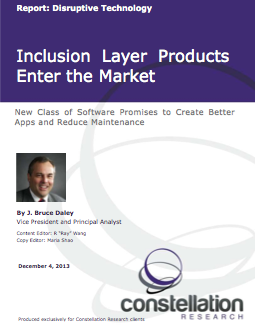 New Class of Software Promises to Create Better Apps and Reduce Maintenance
New Class of Software Promises to Create Better Apps and Reduce Maintenance
Extending enterprise systems into mass market devices such as cell phones, tablets and laptops holds considerable promise to increase user satisfaction, lower costs and improve business efficiency.
Yet, the current approach of or Bring Your Own Device (BYOD) to work is creating a maintenance burden only the very largest IT organizations will be able to address. BYOD-to-work forces IT to support many different, rapidly changing proprietary computer software systems. On many of these devices, new versions of the operating system can be downloaded automatically. As a result, an application that worked one day may not work the next. Driven by the demands of an expanding market for consumer devices, manufacturers such as Apple, Samsung and Google Motorola are innovating rapidly and reducing an already short product life cycle to remain competitive, so the problem will only get worse. Since enterprises represent only a small part of their overall market, the pace of change is unlikely to slacken just to accommodate IT departments. In addition, the current approach of treating mobile devices as the top layer of an existing application software stack has failed to take advantage of some of the unique features of these devices, such as geo-location and cameras, to build new applications. Finally, the current approach ignores the devices’ potential to more cost-effectively integrate information silos.
Fortunately, a number of companies have begun to address these problems and in the process are creating a new class of software which is best understood by an analogy taken from the field of geology - inclusion. In geology, an inclusion takes place when older rock is enclosed inside newer rock. In software, inclusions take place when APIs and device- specific code are enclosed inside a layer of software that manages access, security and identity. The inclusion layer sits above the standard software stack, allowing devices and applications to form compound applications that can be run on mass market devices. Data flows back and forth without the devices nor the applications being designed to work together. Although it is still early days, the new software promises to make end users more productive, give developers more creative and satisfying work, help IT departments lower costs and increase user satisfaction and offer third parties some new highly profitable opportunities for products and services. Despite the challenge of technical complexity and rapid change, IT organizations need to start to weigh the impact this new class of software will have on their business immediately and start to incorporate the new technology in their thinking.
This report describes an emerging class of software that promises to disrupt the marketplace for organizations trying to manage and integrate the increasingly wide array of mobile devices brought to the workplace by employees. It also describes some of the unintended benefits this new class of software brings to organizations seeking to improve end user experiences.
